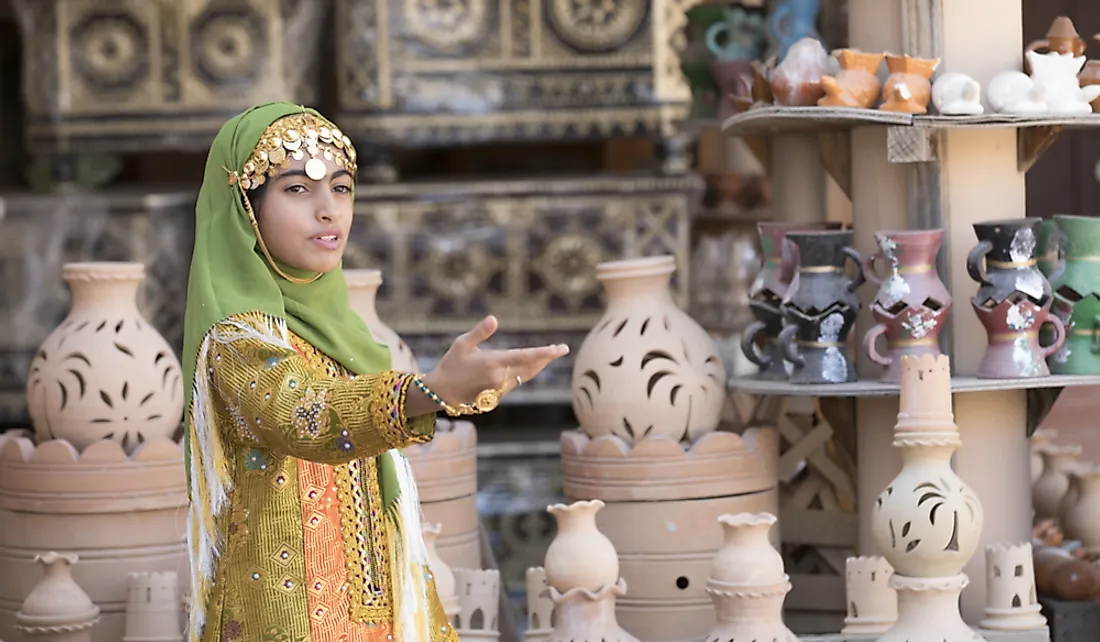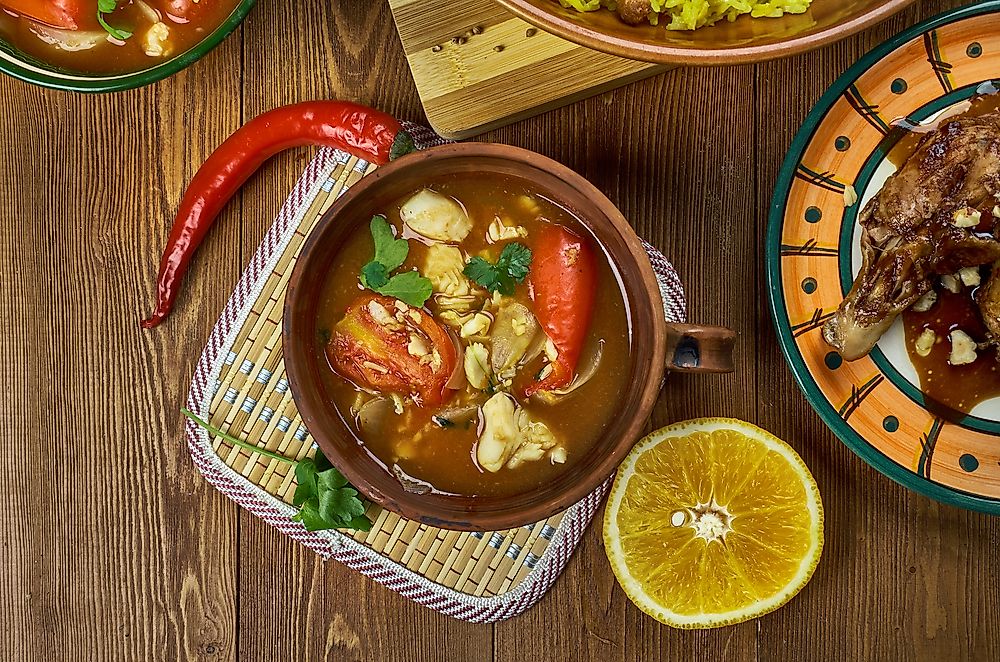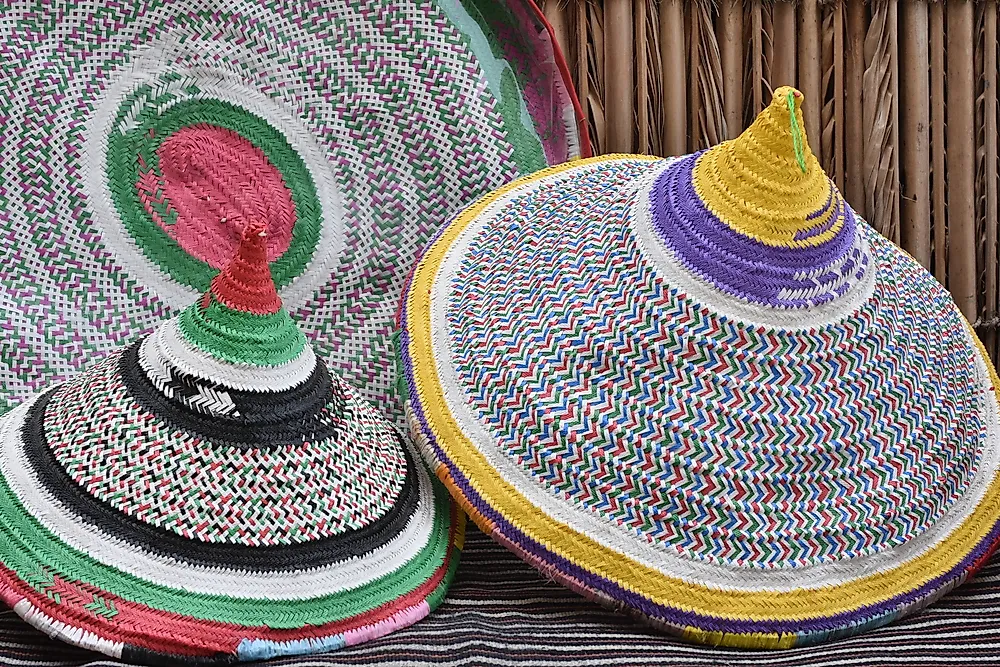The Culture Of Oman

The Western Asian nation of Oman is located in the Arabian Peninsula’s southeastern coast. The culture of the country is steeped in its official religion, Islam. About 4 million people inhabit Oman. The figure includes around 2.23 million Omani citizens. The rest are expatriates from various countries who have migrated to Oman for work. Oman has developed its own subsect of Islam called Ibadhism. However, Sunni and Shia Muslims also reside in the country. About 85.9% of the population of Oman is represented by Muslims. Christians, Hindus, Buddhists, and adherents of other religions comprise the rest of the population. The society of Oman is largely tribal with each tribe having its own culture and customs.
5. Clothing In Oman
The thawb or dishdasha is usually worn by Omani men. It is an ankle-length full-sleeved collarless robe that is generally white in color. Traditional accessories for men include the khanjar (a ceremonial curved dagger), muzzar (a headdress), and the assa (a ceremonial cane). Omani women wear vibrant colored embroidered dresses over trousers called sirwal. They also adorn the lihaf, a headdress. In public, traditional women wear the abaya (a loose-fitting black cloak) and the hijab (a Muslim hair covering).
4. Cuisine In Oman

Omani cuisine is influenced by various global cuisines including Arabic, Persian, Indian, African, etc. Rice is the staple of the cuisine. Fish, lamb, and chicken are other important parts of the diet. Omani dishes are usually rich in herbs, spices, and marinades. Everyday meals feature curry, cooked fish, chicken or meat, rice, and vegetables. Some of the traditional Omani dishes include harees (wheat mixed with chicken or meat and cooked to form a paste), kebabs, machboos (rice cooked in meat or chicken broth with added saffron), Shuwaa (a festive-occasion meal of roasted meat or chicken marinated with a spicy date paste), etc. Kahwa is a popular Omani beverage. It is coffee served with cardamom powder. Tea and yogurt drinks are also popular.
3. Omani Music and Dance
The coastal location of Oman strongly influences its music scene. The interaction between Omani sailors and foreign musicians has helped enrich the music of the country. The traditional Omani music puts a strong emphasis on rhythm. Every stage of the life of an Omani like birth, marriage, and death, is accompanied by traditional music. Dancing is also common during celebrations. A large section of the educated Omanis also enjoys Western dance and music.
2. Literature and Arts in Oman

Past literature of Oman focussed on history and religion. Oral literature, mainly in the form of poetry, plays an important role in the Omani culture. In more recent times, a number of Omani authors have published works of fiction.
Oman has a rich tradition of handicrafts. Silver and gold jewelry, carved swords and daggers, baskets, rugs, pottery water jugs, etc., are some of the famous items produced by artisans in Oman. Since Islam prohibits representation of the human form in paintings, Omani artists usually abide by such rules.
1. Life in the Omani Society
The gender roles in Oman vary with the geography of the nation. Women are more active in economic activities in the desert interiors of the country. There, they also occupy important positions in politics and society. Women are more associated with household duties and childcare in the agricultural oases settlements. In the cities and towns, many women work outside the homes in the education, social service, and other sectors. Omani women are respected and have significant authority in the household. Both men and women take family decisions. Efforts are also made to include more women in the government.
Marriages in Oman are usually arranged, preferably between cousins. Marriages are more of a union between two families. The primary aim is to produce children to continue the future generations. Polygamous marriages are not uncommon. Islam permits up to four wives for a man at any given point of time. Polygamous marriages are more common among rich men as they can afford multiple households. In recent times, men have, however, tended to divorce their former wives and then remarry, leaving many women destitute and at the mercy of the government for financial help.
Domestic units usually comprise of a single extended household or multiple houses within a large compound hosting related families. The residence is patrilocal, that is, wives live with the husband’s family. Elderly men and women in the family have the greatest authority and their decisions are often deemed final in household matters. Inheritance in Oman is based entirely on the Islamic law or Shariah.
Children are taken care of by the mother and other female members of the family. They are expected to be respectful towards the elders and take up adult responsibilities at an early age. Although both girls and boys attend school, dropouts at an early age are common, especially in rural areas. Early marriages and the need to supplement the family income are the most common reasons for such dropouts.
Omanis greet each other with great politeness. The elderly people are offered help by the younger generation. Interactions between non-related members of the opposite sex are usually reserved. Interactions with friends and relatives of the same sex, however, is full of warmth.











